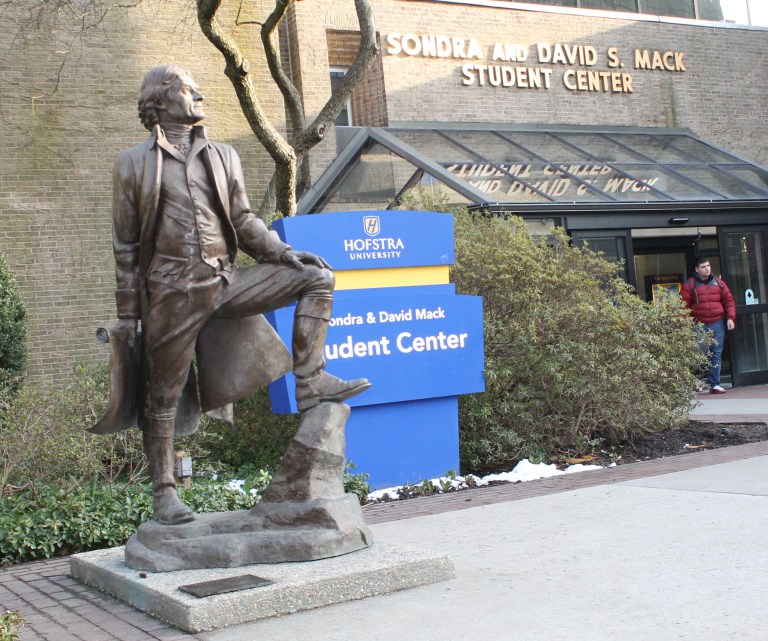
A Thomas Jefferson statue on Hofstra University that was the subject of two online petitions — both to remove and to protect the statue — has been saved by the university’s president.
President Stuart Rabinowitz said in a statement posted to Hofstra’s website on Wednesday that after consulting with students, faculty, administrators, alumni and more, the statue, which stands just outside the Sondra and David S. Mack Student Center, will stay where it is.
In his statement, Rabinowitz said Jefferson was a defender of freedom and helped create the United States, but also said he understood the difficult points of Jefferson’s history, including his slave ownership.
“Yet in the documents most critical to our national character these men of their time laid out a vision of a world in which all people are created equal,” Rabinowitz said. “It is this vision we celebrate and honor in our Founding Fathers, even as we wrestle with their human and indefensible failings.”
Student Richard Caldwell, founder of the online petition to protect the statue, thanked the 1,749 people who signed the petition since its creation two months ago.
“For those of you seeing this that attend Hofstra, I hope now is a time to begin a healing process on campus,” Caldwell wrote on the petition’s site. “This statue controversy brought a great divide and high tensions, and I believe we must continue to have dialogue with each other to try and understand where we all come from.
“Everyone has different opinions based off of their own life experiences, and if we can all try and understand each other, it will be a big step toward a healed campus.”
The dueling petition, started by student Ja’Loni Owens, received 1,140 signatures and called on the university to remove the statue based on Jefferson’s slave ownership.
“For prospective students, this is one of the first buildings that they walk into when touring the university,” Owens wrote. “At almost every single Admitted Students Day, families pose in front of the Student Center to take photos and share hugs and smiles after successful college visits.
“It is unfortunate then that a bronze sculpture of a 71-year-old Thomas Jefferson, gifted to the university by Hofstra Trustee David Mack, is right in front of the Student Center.”
The statue was donated in 1999.
A task force will be formed this fall and will be run by Meena Bose, executive dean for the school’s public policy and public service programs, to continue the conversation about the country’s Founding Fathers, the Atlantic slave trade and “to consider how we use history to advance understanding and build a better, more just world,” Rabinowitz said.







What is truly unfortunate is how poorly educated Hofstra’s students are about Thomas Jefferson and America’s history. Jefferson’s slave population had the highest percentage of white ancestry in America. With an overall measure of the African ancestry of Jefferson slaves well under 50%. For example, Sally Hemings and her siblings were 75% white and 25% black, with Sally described as “near white” in skin tone. That Hemings’ ancestry percentage is the equivalent of a slave owner having 450 white slaves and only 150 black slaves.
As for the statue discussions, Hofstra educators should consider adding the quote of Uriah P. Levy, the first Jewish Commodore of the United States Navy. Levy being an owner and restorer of Monticello. Commodore Levy commissioned and donated the bronze statue of Thomas Jefferson that now resides in the Capitol Rotunda.
Levy wrote, “I consider Thomas Jefferson to be one of the greatest men in history, the author of the Declaration and an absolute democrat. He serves as an inspiration to millions of Americans. He did much to mould our Republic in a form in which a man’s religion does not make him ineligible for political or government life.”
Student Richard Caldwell should start a new petition to have a sign with Levy’s quote posted next to the statue for proper historical context.